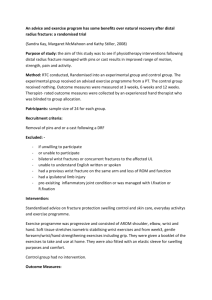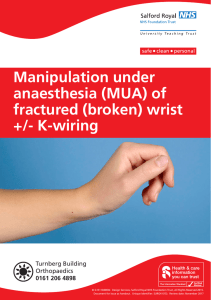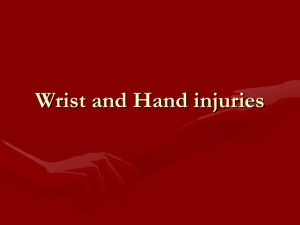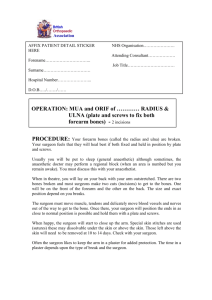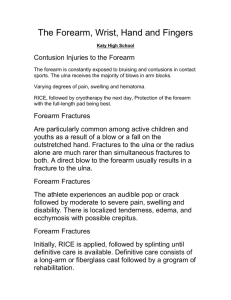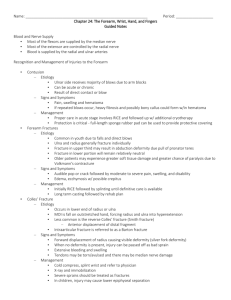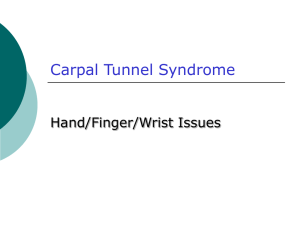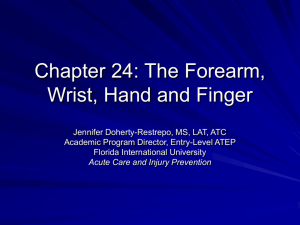Manipulation Under Anaesthesia (MUA) +/- K-wires
advertisement
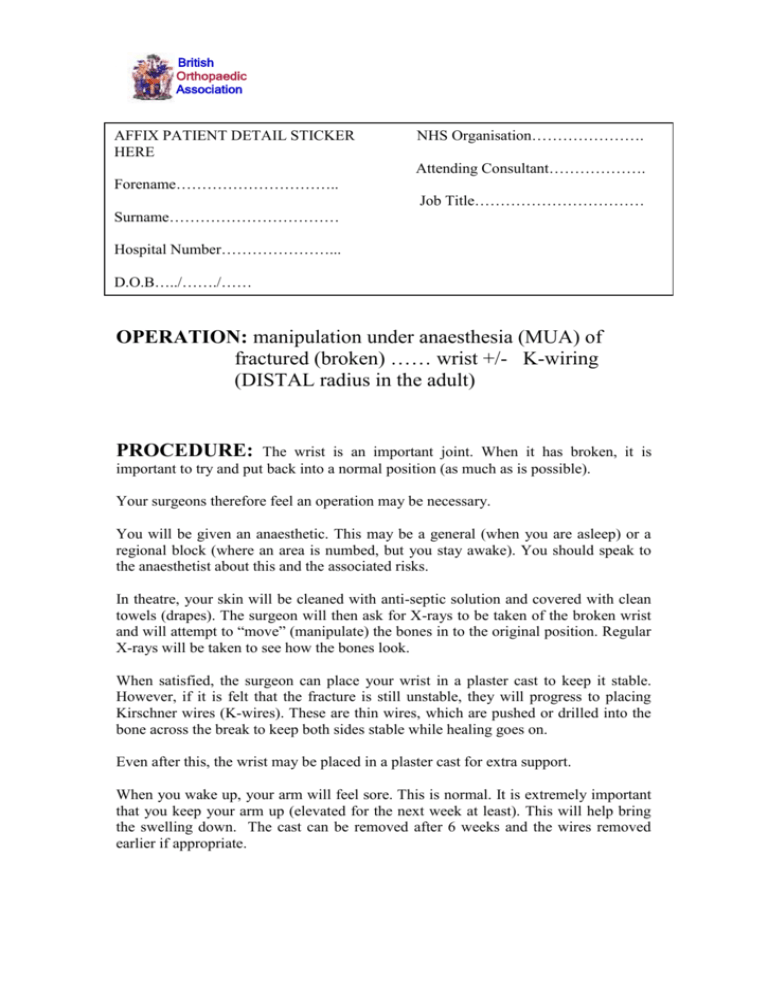
British Orthopaedic Association AFFIX PATIENT DETAIL STICKER HERE NHS Organisation…………………. Attending Consultant………………. Forename………………………….. Job Title…………………………… Surname…………………………… Hospital Number…………………... D.O.B…../……./…… OPERATION: manipulation under anaesthesia (MUA) of fractured (broken) …… wrist +/- K-wiring (DISTAL radius in the adult) PROCEDURE: The wrist is an important joint. When it has broken, it is important to try and put back into a normal position (as much as is possible). Your surgeons therefore feel an operation may be necessary. You will be given an anaesthetic. This may be a general (when you are asleep) or a regional block (where an area is numbed, but you stay awake). You should speak to the anaesthetist about this and the associated risks. In theatre, your skin will be cleaned with anti-septic solution and covered with clean towels (drapes). The surgeon will then ask for X-rays to be taken of the broken wrist and will attempt to “move” (manipulate) the bones in to the original position. Regular X-rays will be taken to see how the bones look. When satisfied, the surgeon can place your wrist in a plaster cast to keep it stable. However, if it is felt that the fracture is still unstable, they will progress to placing Kirschner wires (K-wires). These are thin wires, which are pushed or drilled into the bone across the break to keep both sides stable while healing goes on. Even after this, the wrist may be placed in a plaster cast for extra support. When you wake up, your arm will feel sore. This is normal. It is extremely important that you keep your arm up (elevated for the next week at least). This will help bring the swelling down. The cast can be removed after 6 weeks and the wires removed earlier if appropriate. British Orthopaedic Association ***Please be aware that a surgeon other than the consultant, but with the adequate training or supervision may perform the operation *** ALTERNATIVE PROCEDURE: the fracture may be left in its current position in a plaster. If it is not in a good solid position, it may not heal as well. This will make it more likely to develop arthritis, pain and disability. You may of course seek a second opinion. RISKS As with all procedures, this carries some risks and complications. COMMON (1-5%) Pain: your wrist will be sore after the operation. Keeping the arm up (elevated) most of the time will help reduce the pain and swelling. We will also give you pain killers. If you need more, however, please ask a member of staff. RARE (<1%) Infection: unfortunately, even though the surgeon inserts the wires in theatre where everything is sterile, and your skin is cleaned, there is still a small percent of patients who develop an infection. Most infections will present as redness, swelling or even a discharge of fluid or pus. A course of antibiotic may be needed. If the infection is severe, removal of wires or a further operation may be necessary. Neurovascular damage: there are numerous blood vessels and nerves that run through and around the wrist. This means that they may be damaged by the wires as they are put in. This might lead to numbness or weakness of muscles. This may be temporary or in very rare cases, permanent. Compartment syndrome: this is a build up pressure within the forearm and can cause pain, nerve damage, blood vessel damage and muscle damage. If this occurs, an emergency operation will have to be performed to prevent death of the hand/ forearm muscles. Slipped position; Despite manipulation and cast application, the fracture may still slip (even after K-wiring has been performed). Further operation may be necessary. Removal of wires- The wires will usually be removed after 3 to 6 weeks, once the break has set. This can usually be done in a clinic without any anaesthesia. It doesn’t hurt but feel uncomfortable and strange. Arthritis- and stiffness at the wrist or elbow may occur despite adequate reduction. Arthritis may be more common if the fracture involves the joint. CRP syndrome: this is pain, swelling or stiffness around the fracture site and may occur even months or years after the original injury. British Orthopaedic Association Swelling: it can take up to 6 months for the swelling in the wrist to go down. Stiffenss: the wrist will almost certainly be stiff when you come out of the cast. You may need physiotherapy or occupational therapy to help regain the movement. It’s important that you move your fingers and elbow (if free) even when they are in the cast. Confirmation of consent : The doctor has explained the above complications, risks and alternative treatments to me as well as not having the procedure. I hereby give my consent for the above procedure Signature…………………………………………………. Print name……………………………………………………….... Date………./…/20… 2nd Confirmation………………...............…… .Date…………./…..20…. NAME of SURGEON (Capital letters)……………………………….. SIGNATURE of SURGEON…………………………………………. POSITION…………………………………………………………….. I also give consent for my notes and data to be used in any studies and trials in the future □ If you have any complaints about your treatment or your care, you are always encouraged to discuss them with your surgical team. However, if you wish to complain to the trust, each hospital will have a PALS or Patient Advise and Liaison Service. The head nurse on the ward or out patients’ clinic can direct you to them. The PALS team will treat all complaints seriously.


